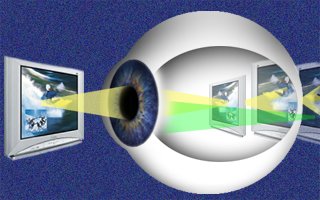|
Astigmatism
| |
|
Astigmatism is a very common disorder
and is easily corrected.
Most of us have some degree of
astigmatism. Astigmatism results in blurred vision at all
distances. It is known as a refractive disorder of the eye.
Refraction is the bending of light. When a light wave enters
the eye, it is bent by the cornea as it makes its way through to
land on the retina.
The cornea, lens and retina
contribute to clear vision at all distances. In astigmatism,
vision is blurred due to either an irregularly shaped cornea or
lens. |
 |
Causes
Lenticular astigmatism is rarer and
caused by an irregularly shaped lens. It is associated with diabetes as
blood sugar levels can result in a change in the lens’ shape. Corneal
astigmatism is much more common and caused by an irregularly shaped
cornea. The cornea is normally symmetrical and round, but in astigmatism
the cornea can become elongated like a football. This causes the light
rays to split in the eye, never achieving a singular point of focus.
Why some people are born with an elongated cornea is unknown. Some
studies show that it could be hereditary. Astigmatism is prevalent in
premature babies and babies born at a low body weight.
Astigmatism can be caused by injury to the eye and subsequent scarring
of the cornea. Some surgeries that can scar the cornea may also cause
astigmatism. Keratoconus, a disease of the eye that causes a thinning of
the cornea to occur, can cause astigmatism by changing the shape of the
cornea.
Onset
and Treatment
Astigmatism reveals itself early. While
slight cases of astigmatism may not need to be corrected, large
amounts of astigmatism can cause blurred vision, headaches and
eye strain.
People who have myopia, nearsightedness, or
hyperopia, farsightedness, are likely to have some degree of
astigmatism. Myopia, hyperopia and astigmatism are all known as
refractive disorders as they affect the way that the eye is able
to bend, or refract, light rays onto the retina.
A
complete eye exam will test for astigmatism. Retinoscopy or an
automatic refraction test may be performed to detect
astigmatism. |
 |
|
Treatment options for astigmatism include eyeglasses or contact lenses.
Orthokeratology is another treatment that involves wearing particular
contact lenses that gradually reshape the cornea into its proper
dimensions.
Advanced Treatment
Advanced treatments for astigmatism include:
•
Laser eye surgery: A surgical procedure where vision is corrected by
removing a small part of the eye with a laser. Using a highly focused
laser beam, a professional cuts away a bit of eye tissue, flattening the
cornea and correcting the focus.
•
Astigmatic keratotomy: A surgical procedure where the cornea is reshaped
by a surgeon. Tiny cuts are made in the cornea along the steepest
curves, refocusing the light that enters the eye to its proper place.
This surgery is replacing laser eye surgery as the preferred treatment
for high levels of astigmatism.
Diagnosis
A diagnosis of astigmatism can be made during the course of a
comprehensive eye exam. A phoropter allows the doctor to show a series
of lenses to a patient, switching back and forth between them to
determine the best fit for corrective lenses.
A keratometer, a
device to measure the curvature of the cornea, may be used as well.
Corneal topography is a technologically advanced treatment where
computer imaging is used to make a map of the cornea. This map provides
the most complete view of the cornea and is used when diagnosing
astigmatism, as well as being used to fit contacts to the eye and
prepare patients for eye surgery.
Prevention
There is no known way to prevent
astigmatism. Maintaining overall health as a means to eye health is
always recommended. Fruits and vegetables high in vitamins A, C and E
are key foods for eye health.
Taking frequent breaks while doing
close work allows the ocular muscles to unwind and can help ward off eye
strain. Try looking off into the distance every ten minutes or so to
keep your eyes relaxed. Wearing sunglasses to prevent UV damage to the
eyes helps keep vision sharp later in life.
When to
see an eye care professional
If you are experiencing
headaches, fatigue, eye strain or blurred vision, you may have
astigmatism and should be examined by an optometrist or ophthalmologist.
Always see an eye care professional immediately if you have any
sudden changes in vision. This includes darkening around the edges of
your vision, dark spots in front of your eyes, halos around bright
lights, a loss of vision in one part of your field of sight or any other
noticeable change.
|